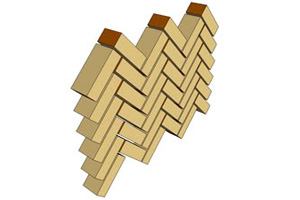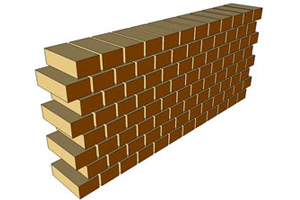Bonds in Brick Masonry
There are various types of bonds generally used in brickworks. A brief description of them is below:
Stretcher bond:
In this type of bond, all the bricks are arranged in the stretcher courses. Care should be taken to break vertical joints by using ½ brickbats. This type of bonds is used for partition walls that are half-brick thick.
Header bond:
In such type of construction, all bricks are arranged in the header courses. This type of bond is useful for the construction of one-brick thick walls.
English bond:
In this bond, alternate courses consist of headers and stretchers. This is the strongest of all bonds and is, commonly used for walls of all thicknesses. To break the continuity of vertical joints, a queen closer is used at the beginning of a wall and end of a wall after the first header.

Flemish bond:
In this type of bond, each course comprises of alternate header and stretcher. Alternate courses start with stretcher and header. To break vertical joints, queen closers are used if the course starts with a header and every header is centrally supported on the stretcher below it. These bonds are of two types:
Double Flemish bond: In this, both faces of the wall have a Flemish look, i.e. each course consists of alternate header and stretcher. It is easy to maintain the correct breaking of joints in this bond, as the number of joints is the consecutive courses are the same, and a fairly uniform face is obtained on both sides of a one-brick wall.

Single Flemish bond: In this case, the outer faces of walls have a Flemish look, whereas inner faces have the English bond look. The only disadvantage of this bond is that it cannot be used for walls of thickness less than 1½ brick and in some portions, long vertical joints are unavoidable.
Dutch bond:
The alternate courses in this type are same as English bond. The difference is in the use of 3/4th bat in stretcher course as quoin. A header is placed next to the 3/4th bat in every alternate stretcher course.
English cross bond:
In this case, the alternate stretcher course has a header placed next to the quoin stretcher. The work is similar to the English bond. This type of bond has a better aesthetic look and possesses greater strength than English bond.
Raking bond:
Raking bonds are used to reduce the effect of the longitudinal stiffness of the wall. Raking courses are to be used at certain intervals along the height of the wall. It is of two types:
Diagonal bond: In this case, the internal placing of the bricks is at a certain angle. The bricks need to be cut into triangular shapes and bonds are provided at every fifth or seventh course in a wall.
Herringbone bond: This type of bond is provided at every sixth or eighth course, if the thickness of the wall is more than four bricks. The bricks are laid at an angle of 45° to make an appearance.
Zigzag bond:
In this, bricks are laid in a zigzag manner, and commonly used for brick facing.
Garden wall bond:
The garden wall bond can be English or Flemish type and used for the construction of compound walls, which are usually one-brick thick.
English garden wall bond:
In this type of bond, one course of headers after three or five courses of stretchers is placed. A queen closer to quoin header is placed to break vertical joints.
Flemish garden wall bond:
In this case, each course comprises one header after three to five stretchers and 3/4th bat at every alternate course to break the vertical joint.
Facing bond:
This type of bond is chosen, when different sizes of bricks are to be used on facing and backing. A one-header course is provided after several stretcher courses. The distance between the successive header courses is equal to the least common multiplier of the thickness of facing and backing bricks.
Check Out:Step by Step Process of Manufacturing Bricks
Technically Reviewed by Rajesh Pagadala, MS, Founder & CEO - BuildersMart. Written by Vani paspula, Content Manager.















